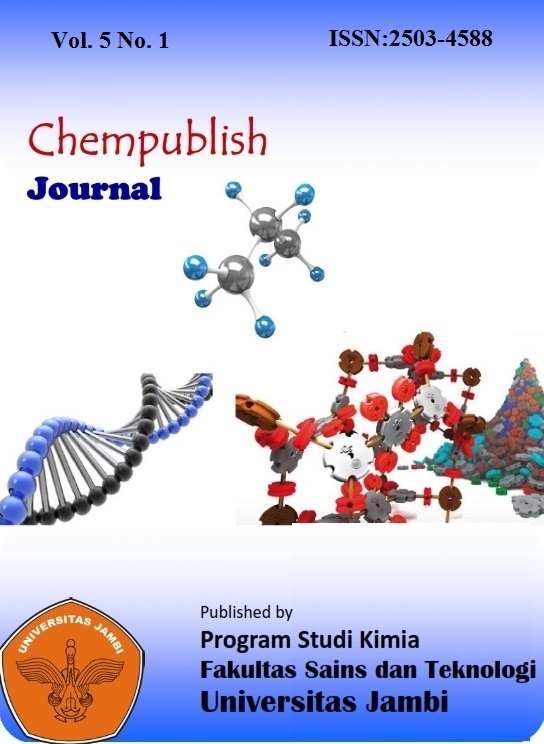Studi komputasi terhadap struktur, sifat antioksidan, toksisitas dan skor obat dari scopoletin dan turunannya
DOI:
https://doi.org/10.22437/chp.v5i1.9023Keywords:
Kimia komputasi, scopoletin, antioksidan, skor obat, toksisitasAbstract
Studi komputasi pada struktur, sifat antioksidan dari scopoletin dan turunannya telah dipelajari melalui analisis DFT/B3LYP/6-31G dalam fase gas. Analisis toksisitas dengan OSIRIS Property Explorer online telah menunjukkan bahwa scopoletin dan turunannya tidak bersifat mutagenik, tidak menyebabkan tumor dan iritasi, akan tetapi beberapa diantaranya memiliki resiko tinggi terhadap sistem reproduksi. Scopoletin dan turunannya memiliki skor obat berkisar antara 0,270 - 0,503 yang menunjukkan bahwa senyawa tersebut memiliki kemiripan obat yang sebanding dengan obat yang ada. Sifat antioksidan scopoletin dan turunannya dapat dijelaskan dengan baik oleh mekanisme transfer atom hidrogen (TAH) dengan nilai BDE berkisar antara 69,986 - 90,510 Kkal/mol dalam fase gas. Nilai BDE sangat dipengaruhi oleh sifat substituen dan ditemukan bahwa substituen pendorong elektron menurunkan nilai BDE. Nilai BDE menurun dengan urutan dari senyawa 9>6>7>8> scopoletin >1>10>3>5>4>2 dalam fase gas, sehingga urutan kemampuan mendonasikan atom hidrogen adalah 2>4>5>3>10>1> scopoletin >8>7>6 >9. Nilai ΔBDE dari scopoletin dan turunannya pada fase gas berkisar dari -16,064 hingga 4,460 Kkal/mol. Nilai BDE fase gas yang dihitung secara signifikan lebih rendah daripada nilai SET-PT dan PA pada fase gas. Hasil ini lebih lanjut menunjukkan bahwa TAH secara termodinamika lebih disukai daripada SET-PT, PA dan ETE dalam fase gas.
Downloads
References
Alrawaiq, N.S., Azman, A. 2014. A review of flavonoid Quercetin: metabolism, bioactivity and antioxidant properties, Int. J. PharmTech Res. 6, 933–941.
Becke, A.D. 1993. Density-functional thermochemistry. III. The role of exact exchange. J. Chem. Phys. 5648-5652.
Chen, Y., Xiao, H., Zheng, J., Liang, G. 2015. Structure-thermodynamics-antioxidant activity relationships of selected natural phenolic acids and Derivatives: an experimental and theoretical evaluation, PLoS One 10, 1-20.
Choe, E., David, B.M. 2009. Mechanisms of antioxidants in the oxidation of foods, Comprehensive Reviews in Food Science and Food Safety 8, 345-358.
Daina, A., Michielin, O., Zoete, V., Swiss. 2017. ADME: a free web tool to evaluate pharmacokinetics, drug- likeness and medicinal chemistry friendliness of small molecules, Sci. Rep. 7, 1-13.
Ertl, P., Rohde, B., Selzer, P. 2000. Fast calculation of molecular polar surface area as a sum of fragment-based contributions and its application to the prediction of drug transport properties, J. Med. Chem. 43, 3714-3717.
Finley, J.W., Ah-Ng K., Korry H., Elizabeth H.J. 2011. Antioxidants in foods: state of the science important to the food industry. Journal of Agricultural Food Chemistry 59, 6837-6846.
Friedman, M., Nobuyuki, K., Hyun, J.K., Suk, H.C. 2017. Glycoalkaloid, phenolic, and flavonoid content and antioxidative activities of conventional nonorganic and organic potato peel powders from commercial gold, red, and Russet potatoes, J. Food Compos. Anal. 62, 69–75.
Hassan, B., Shireen, A., Muraleedharan, K., Mujeeb, V.M.A. 2015. Virtual screening of molecular properties of chitosan and derivatives in search for druggable molecules, Int. J. Biol. Macromol. 74, 392-396.
Katritzky, A.R., Karelson, M., Lobanov, V. 1996. Quantum-chemical descriptors in QSAR/QSPR studies. J. Am. Chem. Soc. 96(3), 1027-1044.
Li, D., Li, B., Ma, Y., Sun, X., Lin, Y., Meng, X. 2017. Polyphenols, anthocyanins, and flavonoids contents and the antioxidant capacity of various cultivars of highbush and half-high blueberries, J. Food Compos. Anal. 62, 84–93.
Mendes, R.A., Shawan, K.C. 2018. A computational investigation on the antioxidant potential of myricetin 3,4’-di-O-α-L -rhamnopyranoside. J Mol Model 24(133), 1-8.
Petko, A. 2015. Computational studies of free radical-scavenging properties of phenolic compounds. Current Topics in Medicinal Chemistry 15, 85-104.
Ponnam, D.K., Srinivas, K.V.N., Jonnala, K.K., Kumar, T., Savita, B., Kakaraparthi, P.S. 2014. Phytochemical investigation, antioxidant, and antifungal activities of Rhizomes of Euphorbia fusiformis, Phcog J, 6(4), 78-82.
Rodrigo, A.M., Shawan, K.C.A., Luri, N.S., Cristina, A.B. 2018. A computational investigation on the antioxidant potential of myricetin 3,4’-di-O-α-L –rhamnopyranoside. J Mol Model 24(133), 1-8.
Sarkar, A., Middya, T.R., Jana, A.D. 2011. A QSAR study of radical scavenging antioxidant activity of a series of flavonoids using DFT based quantum chemical descriptors - the importance of group frontier electron density, Journal of Molecular Modeling 18(6), 2621-2631.
Veber, D.F. 2002. Molecular properties that influence the oral bioavailability of drug candidates, J. Med. Chem. 45, 2615-2623.
Vijisha, K.R., Ragi, C., Muraleedharan, K. 2019. A computational exploration into the structure, antioxidant capacity, toxicity and drug-like activity of the anthocyanidin “Petunidinâ€. Heliyon 5, 1-9
Vijisha, K.R., Hasna, C.K., Muraleedharan, K. 2018. The natural food colorant Peonidin from cranberries as a potential radical scavenger – a DFT based mechanistic analysis. Food Chem. 262, 184-190.
Vijisha, K.R., Shameera, A., Muraleedharan, K. 2018. Studies on the UV filtering and radical scavenging capacity of the bitter masking flavanone Eriodictyol, J. Photochem 185, 254-261.
Wang A., Yang, L., Peng, H.S., Hui, Z. 2018. A theoretical study on the antioxidant activity of Uralenol and Neouralenol scavenging two radicals, Struct. Chem. 29, 1067-1075.
Wright, J.S., Erin, R.J., Gino, A.D. 2001. Predicting the activity of phenolic antioxidants: theoretical method, analysis of substituent effects, and application to major families of antioxidants. J Am Chem Soc. 123, 1173-1183.
Yunsheng, Xue., Youguang, Z., Ling, Z., Wenya, W. 2013. Theoretical study on the antioxidant properties of 2′-hydroxychalcones: H-atom vs. Electron transfer mechanism, J Mol Model 19, 3851-3862
Zhou, H., Li, H., Shang, Y., Chen, K. 2019. Radical scavenging activity of puerarin: a theoretical study, Antioxidants 8(12), 2-9.
Downloads
Published
Versions
- 2020-05-31 (1)
- 2020-05-31 (1)





